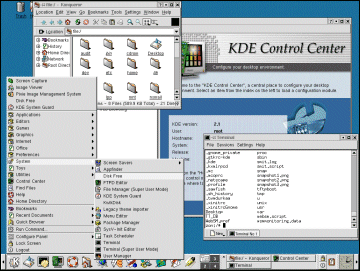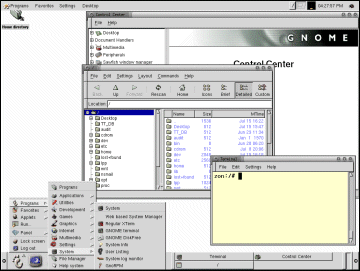Who's
afraid
of Linux?
I teach AIX system administration
on RS/6000 systems. Why should I be interested in Linux? Somehow it seems I can't
escape from it: in april IBM announced AIX
5L which has Linux affinity ... the AIX Toolbox for
Linux Applications,
and recently the Redbook Running Linux Applications on AIX,
and there is a large number of Linux Courses at IBM Learning Services.
And I was told you can run Linux on RS/6000 and eServer pSeries hardware.
I even read that Linux can become the successor of AIX ... hmm. It's
time to get informed ...
About Linux
Linux is an operating system based on Unix. The kernel was originally developed by
Linus Torvalds
in Helsinki, Finland, with the assistance of developers from around the
world. The necessary programs were provided by Richard
Stallman and GNU in Cambridge, Massachusetts. GNU
is an Open Source software community that has developed a number of very
usefull application development tools. Applications that made Linux
succesful are Apache HTTP web server, Sendmail and Samba (NT File and
Print server emulator).
 "some people have told me they don't think a fat penguin embodies the grace of Linux, which just tells me that they have never seen an angry penguin charging at them in excess of 100 mph. They'd be a lot more careful about what they say if they had" "some people have told me they don't think a fat penguin embodies the grace of Linux, which just tells me that they have never seen an angry penguin charging at them in excess of 100 mph. They'd be a lot more careful about what they say if they had"
- Linus Torvalds
The initial release of Linux was distributed by means of the Internet
(1991),
and generated one of the largest software development phenomena of all
time. It is the fastest growing operating system today, renowned for speed,
reliability and stability. It runs on many different kinds of hardware
including Alpha, Intel, PowerPC, Macintosh, SGI, Sun SPARC, S/390.
The Linux source code can be freely distributed and is available to the
general public under the GNU General
Public Licence (GPL). You can download Linux from the Internet, but
it is easier to use a Linux distribution. Major distributions are Caldera,
Red Hat,
SuSE, TurboLinux.
Together with many, many other distributions you can find them at www.linux.org,
a key website for Linux.
Today the Linux Operating System is used on around 10 million computers
in small businesses, Internet Service Providers (ISPs), and more and more the corporate IS
world.
Linux has more than ten different, highly
configurable graphical interfaces (known as window managers) running on
top of XFree86, a free implementation of the X Window System. The most
popular window managers are KDE (the K Desktop
Environment with the KOffice Suite), and GNOME
(the GNU Network Object Model Environment). I personally prefer the KDE,
even more than using the CDE
(Common Desktop Environment), which by the way is available for Linux
too... (commercial).
If you want a Linux box
running KDE to look like a Mac, Windows, or NextStep machine, you can do
it with a few mouse clicks. Tasks like system administration, package
installation, upgrading, and network configuration can be done easily
through graphical programs (you can click on the images to see the full
size image of the KDE and Gnome Desktops).
Most of the development software for
Linux is free and covered under the GNU Public License. Linux systems
come standard with C and C++ compilers and an assembler, often include
Pascal, FORTRAN, and BASIC, modern languages like Perl and Python and
classic languages like LISP. Because the source code is free (Open
Source) the development of software proceeds at a faster pace than at
commercial software houses.
 Commercial applications for Linux are IBM's DB2 database, WebSphere, Lotus
Domino, Oracle and
Informix databases,
SAP R/3, Corel's Wordperfect Office
2000, Sun's StarOffice
productivity suite (no longer free), AnywareOffice
(formerly titled ApplixOffice) and OpenOffice.org
(free, based on StarOffice sources). Commercial applications for Linux are IBM's DB2 database, WebSphere, Lotus
Domino, Oracle and
Informix databases,
SAP R/3, Corel's Wordperfect Office
2000, Sun's StarOffice
productivity suite (no longer free), AnywareOffice
(formerly titled ApplixOffice) and OpenOffice.org
(free, based on StarOffice sources).
For Dos and Windows emulation you can use dosEMU (older DOS
applications), WABI environment (16-bit Windows applications),
WINE API-emulator
(32-bit Windows applications), VMware (multiple virtual computers on a single
PC). There are also emulators for Atari, Commodore, Mac, and more ... 
Some of the Open
Source Projects from IBM:
- The Journaled
File System (JFS), provides a log-based, byte-level file system
that was developed for transaction-oriented, high performance
systems
- AFS,
is a very scalable, highly available, and secure file system with a
very robust data management model for ease of administration
- EVMS,
Emulating Multiple Logical Volume Management Systems within a Single
Volume Management Architecture
 RS/6000 & pSeries: AIX affinity
with
Linux RS/6000 & pSeries: AIX affinity
with
Linux
The AIX Toolbox for Linux Applications consists of a group of GNU and
Open Source tools and utilities for building and deploying Linux
applications on AIX and includes a collection of programs that have been
recompiled and tested.
AIX affinity (for AIX version 4.3.3 and 5L) with Linux includes:
- Linux application source
compatibility, including APIs and LSB (Linux Standard Base)
subroutines
- Compliance with emerging Linux
standards
- GNU Linux build-time environment with
GNU and other open source tools and utilities that combine to
facilitate the development and deployment of Linux applications on
AIX
The AIX affinity with Linux allows Linux
programs to be easily recompiled for native execution on AIX.
Last week I installed the AIX Toolbox for Linux
applications. What does it offer:
- Build and package Linux applications
for use on AIX
- Run Gnome and KDE-2 desktops
- Run other popular software commonly
found in Linux distributions (emacs, vim, gzip, zip, unzip, samba,
apache webserver, bash2, tcsh, zsh, etc.)
- Manage open source software using the
popular RPM package management system
- Develop new applications for AIX using
GNU and Linux application development tools (GNU C-compiler gcc, GNU
C++-compiler g++)
The complete list: AIX
Toolbox for Linux applications
Article on Linux Affinity in the Sys Admin Magazine of June 2001  . .
RS/6000 & pSeries: native Linux
Is Linux, instead of AIX, the operating system of choice for the pSeries
in some years from now?
"We are happy and comfortable with the idea that Linux can become
the successor not just for AIX but for all Unix operating systems,"
said Steve Mills, senior vice president and group executive of the IBM
Software Group.
Read more in the article at IDG.net When
Linux grows up, IBM glad to boot AIX.
You can run Linux on some RS/6000 and pSeries systems:
www-1.ibm.com/servers/eserver/pseries/linux
Linux for pSeries: An overview for customers
A tabel of all RS/6000 & pSeries hardware that run Linux:
Linux
for pSeries system guide
Also take a look at the IBM PowerPC Linux team and the community of
PowerPC Linux developers (their goal is to improve, and extend Linux for
PowerPC Microprocessors):
www.oss.software.ibm.com/developer/opensource/linux/projects/ppc
Since 1996, www.linuxppc.org
has been the home of the PowerPC Linux project, the native port of
GNU/Linux to the PowerPC processor. The site is run and maintained by
volunteers.
Read more on Linux
AIX Affinity with Linux Technology paper:
www-1.ibm.com/servers/aix/products/aixos/linux/affinity_linux.pdf
IBM Linux Resource Portal: www.ibm.com/linux
IBM Linux Technology Center: www.oss.software.ibm.com/developer/opensource/linux
IBM Education & Training: www.ibm.com/services/learning/spotlight/linux/
Free IBM e-Learning Course: QLX01
- A Linux Introduction
A list of Redbooks on Linux:
publib-b.boulder.ibm.com/cgi-bin/searchsite.cgi?query=Linux
Linux Documentation project: www.linuxdoc.org
ZDNet: IBM:
Linux can take on the world
And let's not forget Humorix: www.i-want-a-website.com/about-linux
And some Linux fun from IBM: http://www-1.ibm.com/servers/eserver/linux/fun/index.html
Linux Newsgroups: www.linux.org/docs/usenetlinux.html
Linux (and Certification) : http://www.unixreview.com/
Other Linux sites of interest: www-1.ibm.com/linux/links/index.shtml
Are you still afraid?

|
 "some people have told me they don't think a fat penguin embodies the grace of Linux, which just tells me that they have never seen an angry penguin charging at them in excess of 100 mph. They'd be a lot more careful about what they say if they had"
"some people have told me they don't think a fat penguin embodies the grace of Linux, which just tells me that they have never seen an angry penguin charging at them in excess of 100 mph. They'd be a lot more careful about what they say if they had"

 RS/6000 & pSeries: AIX affinity
with
Linux
RS/6000 & pSeries: AIX affinity
with
Linux